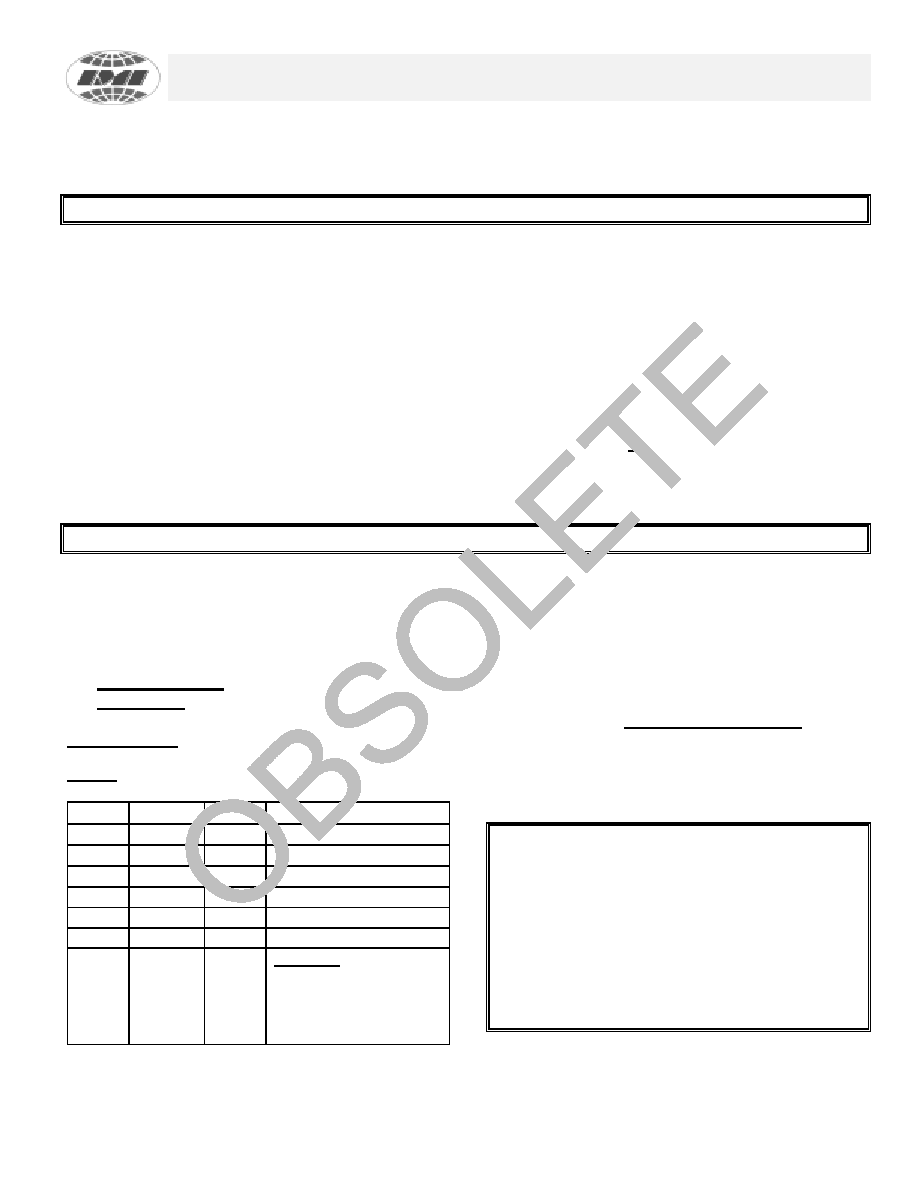- 您現(xiàn)在的位置:買賣IC網(wǎng) > PDF目錄67720 > IMISC670DYB PROC SPECIFIC CLOCK GENERATOR, PDSO48 PDF資料下載
參數(shù)資料
| 型號: | IMISC670DYB |
| 元件分類: | 時鐘產(chǎn)生/分配 |
| 英文描述: | PROC SPECIFIC CLOCK GENERATOR, PDSO48 |
| 文件頁數(shù): | 7/12頁 |
| 文件大?。?/td> | 505K |
| 代理商: | IMISC670DYB |

SC670
I
2C Clock Generator for Pentium Notebook Designs.
Approved Product
INTERNATIONAL MICROCIRCUITS, INC. 525 LOS COCHES ST.
Rev.1.4
6/20/97
MILPITAS, CA 95035. TEL: 408-263-6300. FAX 408-263-6571
Page 4 of 12
2-WIRE I
2C CONTROL INTERFACE
The 2-wire control interface implements a write only slave interface. The IMISC670 cannot be read back. Sub-
addressing is not supported, thus all preceding bytes must be sent in order to change one of the control bytes. The 2-
wire control interface allows each clock output to be individually enabled or disabled. It also allows 24/48 MHZ frequency
selection and test mode enable.
During normal data transfer, the SDATA signal only changes when the SDCLK signal is low, and is stable when
SDCLK is high. There are two exceptions to this. A high to low transition on SDATA while SDCLK is high is used to
indicate the start of a data transfer cycle. A low to high transition on SDATA while SDCLK is high indicates the end of a
data transfer cycle. Data is always sent as complete 8-bit bytes, after which an acknowledge is generated. The first
byte of a transfer cycle is a 7-bit address with a Read/Write bit as the LSB. Data is transferred MSB first.
The IMISC670 will respond to writes to 10 bytes (max) of data to address D2 by generating the acknowledge
(low) signal on the SDATA wire following reception of each byte.
The IMISC670 will not respond to any other control
interface conditions. The I
2C interface is disabled when the PWR_DWN# pin is low. Previously set control registers are
retained.
SERIAL CONTROL REGISTERS
NOTE: The Pin# column lists the affected pin number where applicable. The @Pup column gives the state
at true power up. Bytes are set to the values shown only on true power up, and not when the PWR_DWN#
pin is activated.
Following the acknowledge of the Address Byte (D2), two additional bytes must be sent:
1) “Command Code “ byte, and
2) “Byte Count” byte.
Although the data (bits) in these two bytes are considered “don’t care”, they must be sent and will be
acknowledged.
Byte 0: Function Select Register (1 = enable, 0 = Stopped)
Bit
@Pup
Pin#
Description
70
*
Reserved, Don’t set
60
*
Reserved, Don’t set
50
*
Reserved, Don’t set
40
*
Reserved, Don’t set
3
1
23
48/24 Mhz
2
1
22
48/24 Mhz
1
0
Bit1 Bit0
1
1 Tri-State
1
0 Reserved
0
1 Test Mode
0
Normal
IMPORTANT NOTE
Reserved bits are intended for possible
future functions. It is important that they
be left at their Power Up logic levels at all
times. Otherwise data sheet specifications
cannot be guaranteed.
相關(guān)PDF資料 |
PDF描述 |
|---|---|
| IMISG522BXB | OTHER CLOCK GENERATOR, PDSO16 |
| IMISG522BX | 120 MHz, OTHER CLOCK GENERATOR, PDSO16 |
| IMISG524BX | 120 MHz, OTHER CLOCK GENERATOR, PDSO16 |
| IMISG570CYB | PROC SPECIFIC CLOCK GENERATOR, PDSO48 |
| IMISG570CYB | PROC SPECIFIC CLOCK GENERATOR, PDSO48 |
相關(guān)代理商/技術(shù)參數(shù) |
參數(shù)描述 |
|---|---|
| IMISC671CTB | 制造商:未知廠家 制造商全稱:未知廠家 功能描述:CPU System Clock Generator |
| IMISC671CYB | 制造商:未知廠家 制造商全稱:未知廠家 功能描述:CPU System Clock Generator |
| IMISC671DYB | 制造商:未知廠家 制造商全稱:未知廠家 功能描述:CPU System Clock Generator |
| IMISC674BYB | 制造商:未知廠家 制造商全稱:未知廠家 功能描述:CPU System Clock Generator |
| IMISC675AYB | 制造商:未知廠家 制造商全稱:未知廠家 功能描述:Miscellaneous Clock Generator |
發(fā)布緊急采購,3分鐘左右您將得到回復(fù)。